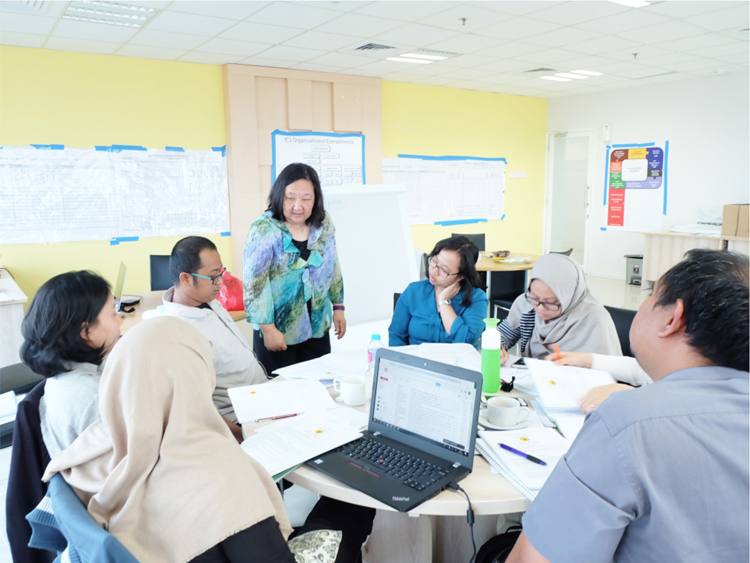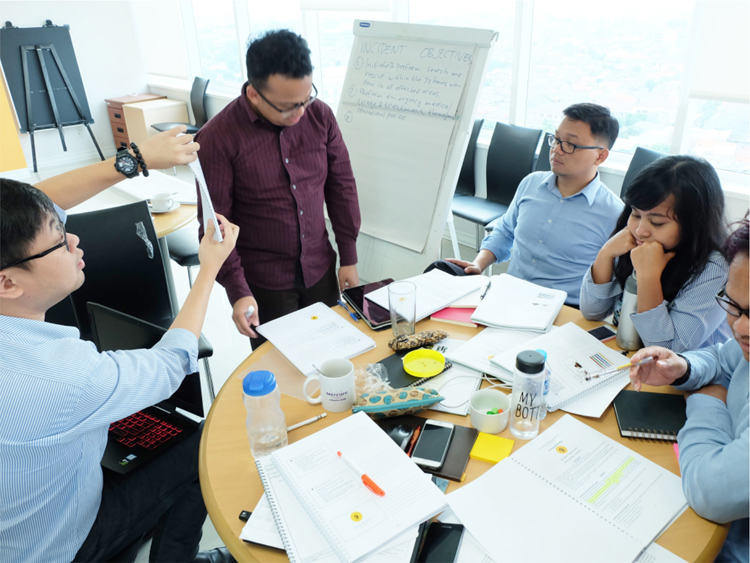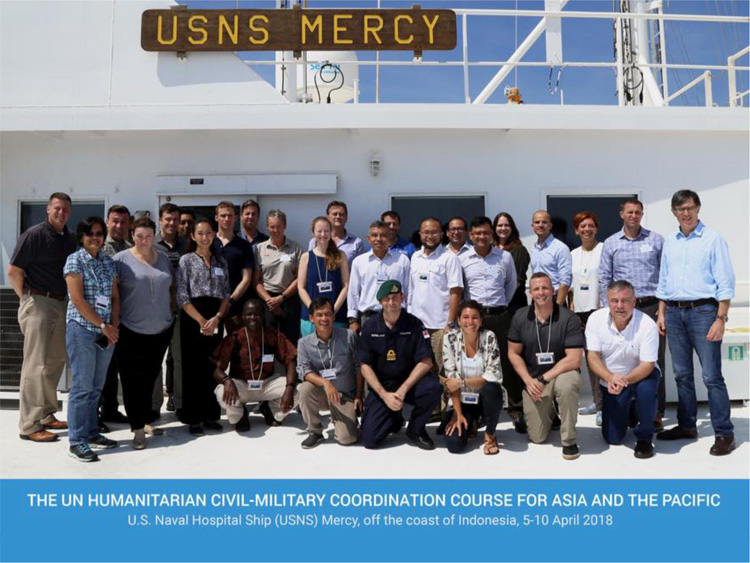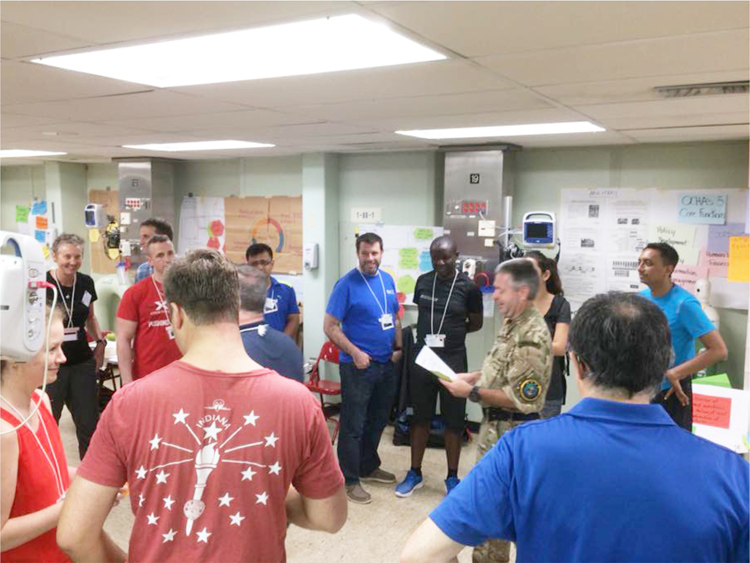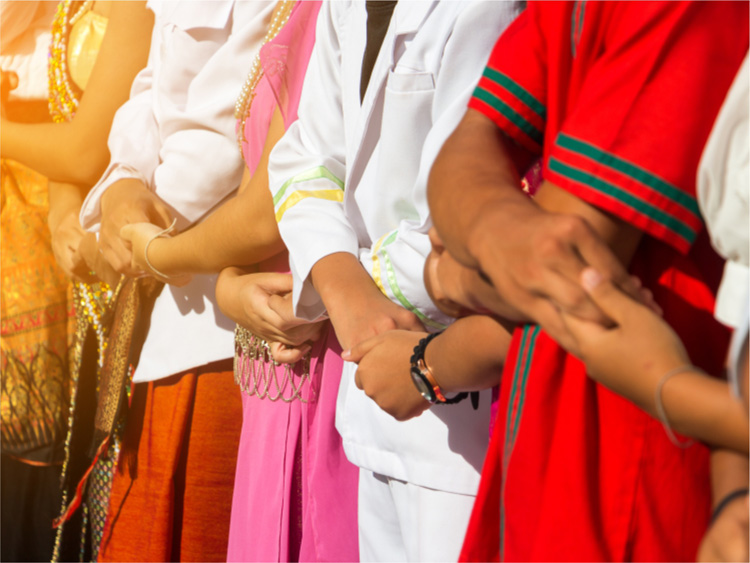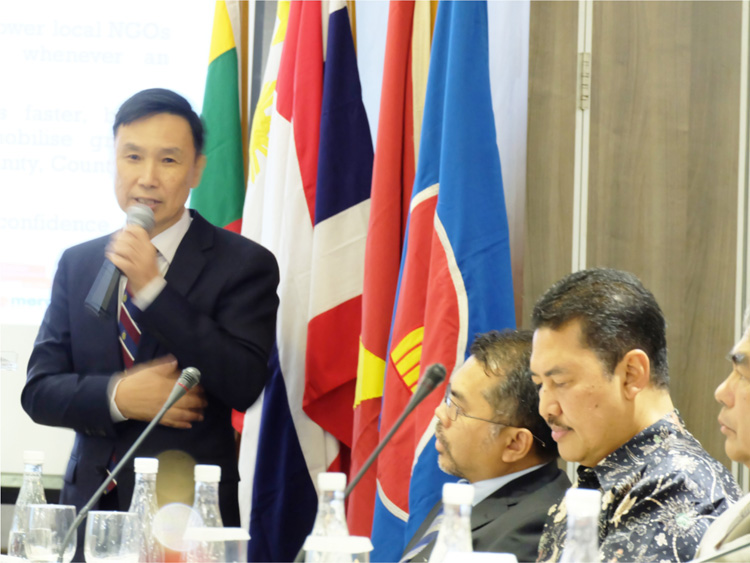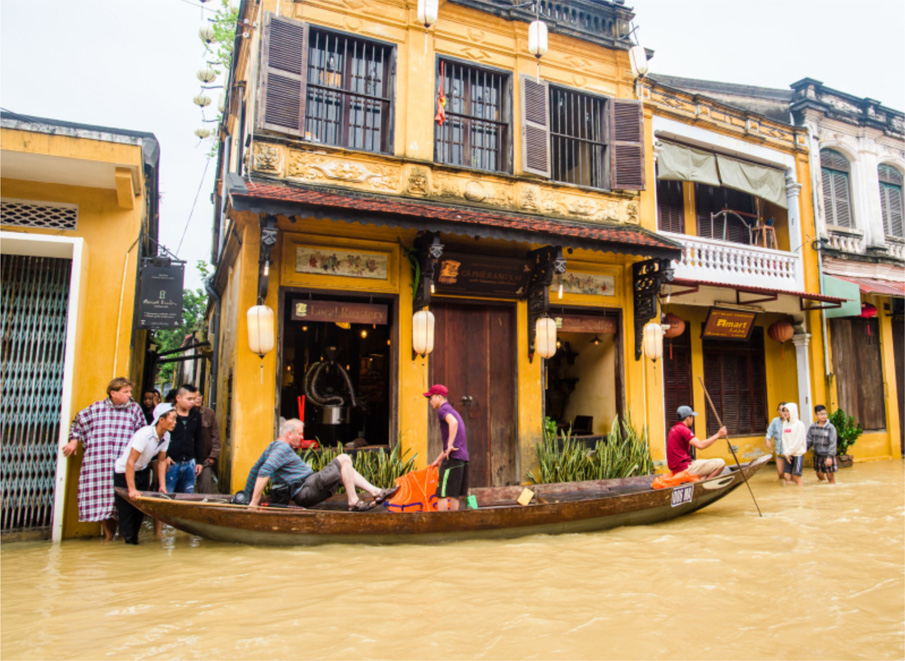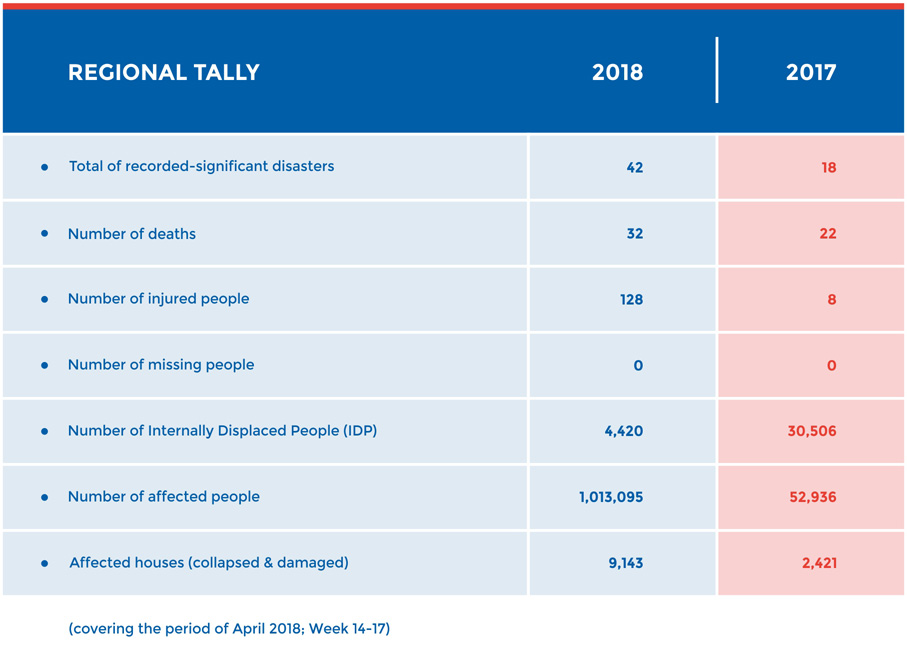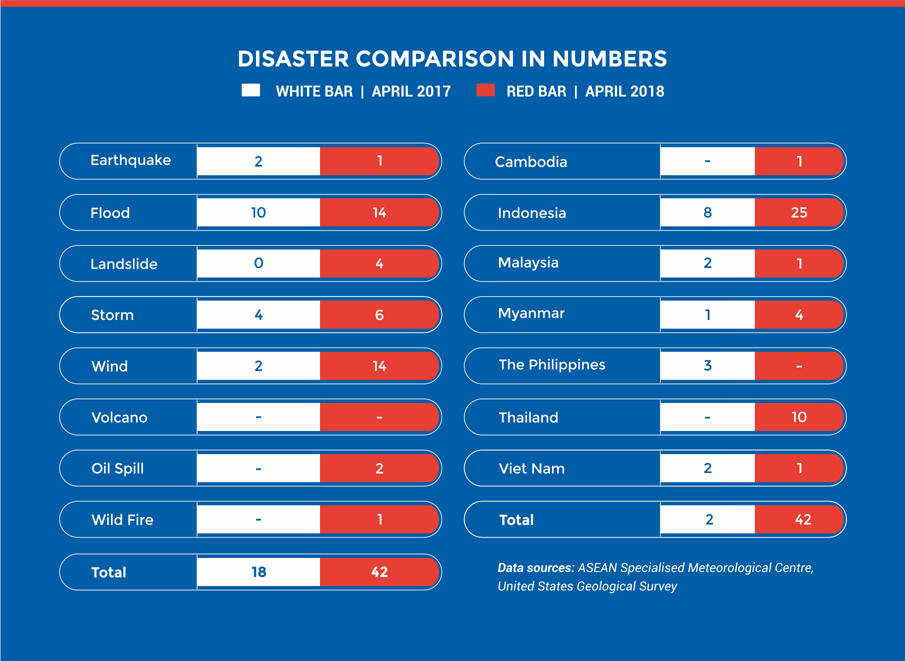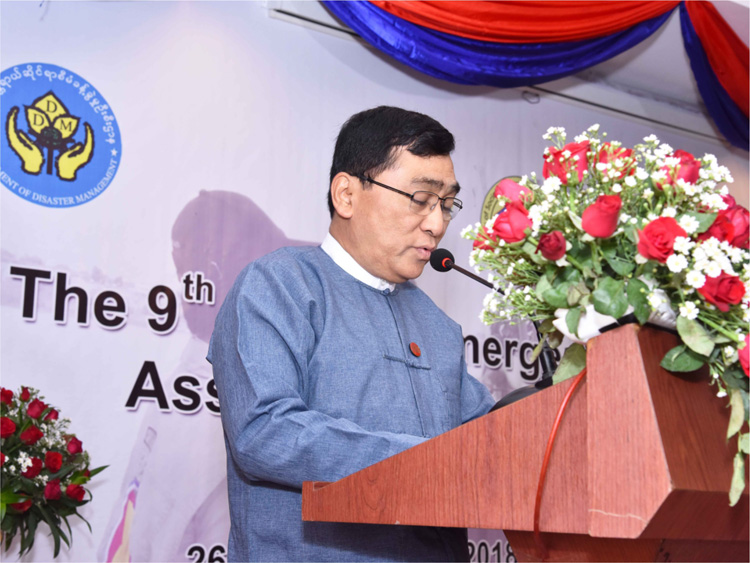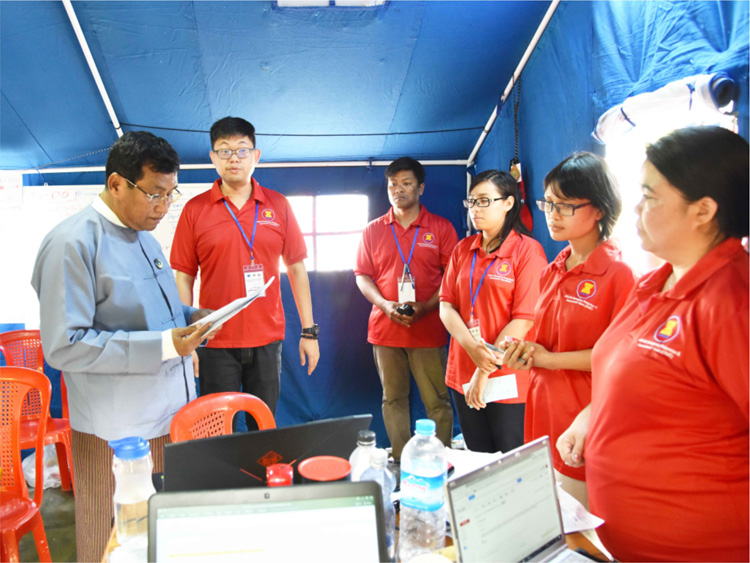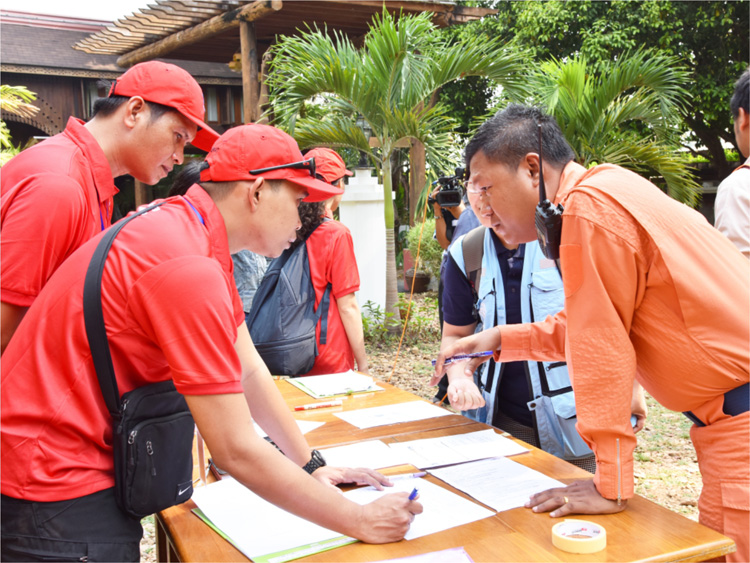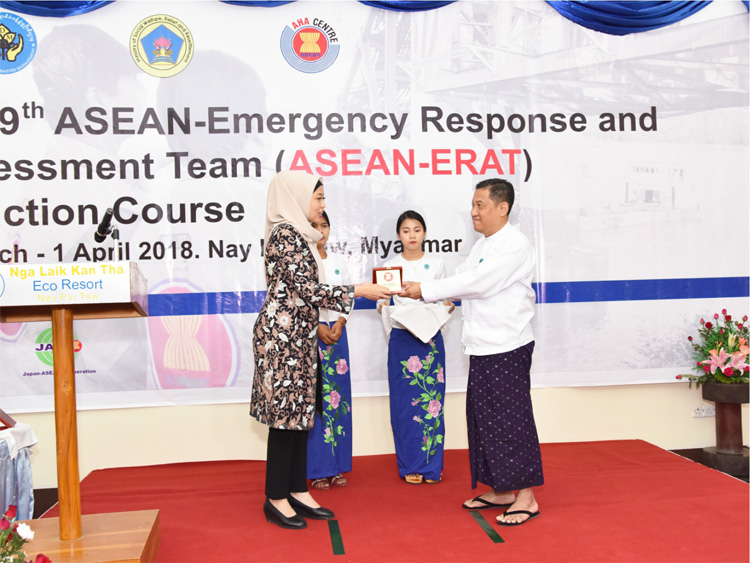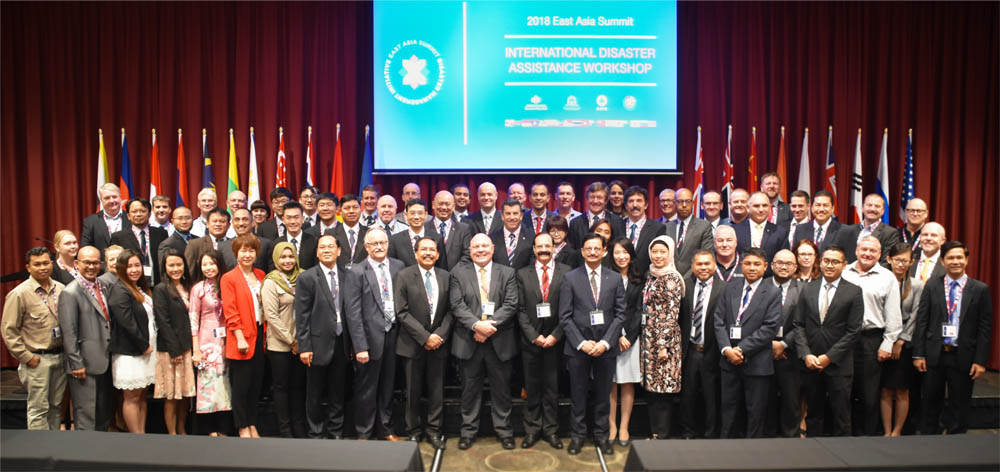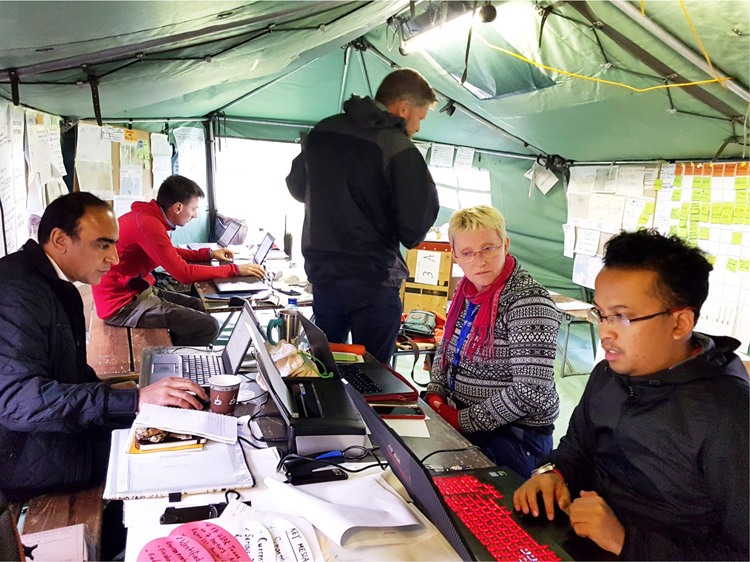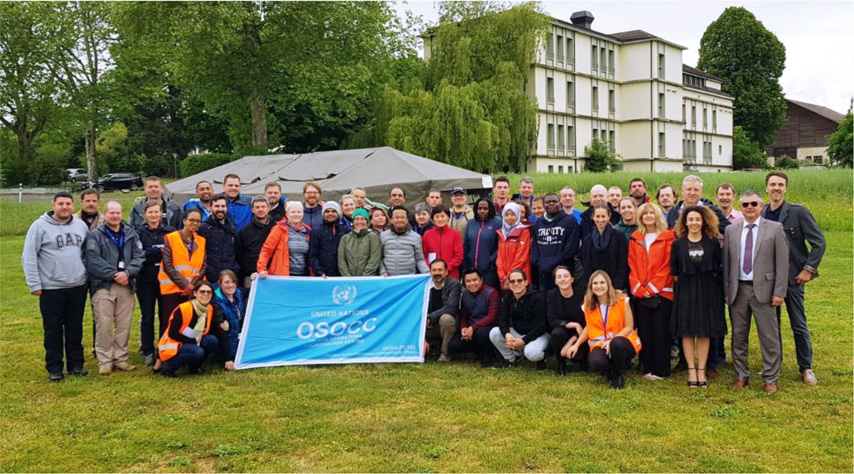Vol 38-Incident Command System and Incident Action Planning Workshops

INCIDENT COMMAND SYSTEM
AND INCIDENT ACTION PLANNING WORKSHOPS
JAKARTA, 16-27 APRIL 2018
During April 2018, the AHA Centre, with the support of the United States Forest Service (USFS), successfully conducted intensive trainings regarding the Incident Command System and Incident Action Planning.
The Incident Command System (ICS) model, first developed in the 1970s in the aftermath of wildfires in California and Arizona, encourages the use of a standardised management system to enable a synergised inter-agency collaboration when responding to an emergency. To date, ICS has been developed and adjusted to address various complexities and types of emergency responses, including during the first attack of the World Trade Centre in 1993. Alongside this, ICS is also applicable for managing non-emergency situations – such as public events which attract massive crowds – including sporting events, annual festivals, parades and concerts.
While ICS covers the basic principles of cross-sectoral coordinating mechanisms, Incident Action Planning (IAP) provides in-depth knowledge for the planning department of the AHA Centre whenever a need for disaster-response arises. The IAP trainings involved
case studies in which the AHA Centre’s staff were challenged to practice their skills, use their creativity, and draw on their knowledge to develop strategies to address various disaster scenarios, including landslides, floods, and fires. The evolving scenarios required continuous efficient response plans, factoring in analysis from available resources, logistical aspects, and also safety and security.
Both ICS and IAP have been adapted and utilised by the AHA Centre since its establishment as the coordinating agency for humanitarian assistance in Southeast Asian region. The dynamic nature of ICS has been effective for the Centre’s emergency operations, due to its flexibility and adjustability to suit a range of responses. The ICS system has also been adapted and is currently used by five ASEAN Member States, creating coordination and a common ground for the ever-growing regional collaborations in managing disasters.
Written by : Shintya Kurniawan | Photo : AHA Centre
- Published in AHA Centre Diary 2
Vol 38-Humanitarian Civil-Military Coordination (UN-CMCOORD) Training

HUMANITARIAN CIVIL-MILITARY
COORDINATION (UN-CMCOORD) TRAINING
BENGKULU, 5-10 APRIL 2018
On 5th–10th of April 2018, the AHA Centre participated in a Humanitarian Civil-Military Coordination (UN-CMCOORD) training, conducted on-board the US Naval Hospital Ship (USNS) Mercy in Bengkulu, Indonesia. The training was implemented by the United Nations Office for the Coordination of Humanitarian Affairs (UNOCHA) alongside the United States Pacific Fleet.
As military institutions often play a significant role within emergency responses, there is a real need to foster meaningful collaboration between military actors, civilians, and other international humanitarian organisations. This sees UNOCHA facilitating trainings such as the UN-CMCOORD on a regular basis across the world. The training’s underlying principle is to create and share common understanding for the facilitation of the right assistance, to the right people, at the right time, and using the most appropriate methods during emergency response. The training included a variety of modules, such as coordination and sharing of resources, protection of civilians, and the security of humanitarian aid workers – an effort that has developed the global #NotATarget campaign.
The participants in the UN-CMCOORD training held a range of diverse backgrounds. Alongside military representatives and UNOCHA staff, representatives from non-governmental organisations, National Disaster Management Organisations, regional organisations, and the International Red Cross/Crescent Societies were also involved. However, this event stands as the first time such a training was conducted on a military vessel. The USNS Mercy was originally an oil tanker, redeveloped into a military medical hospital, complete with a surgery operation room for humanitarian assistance and disaster response operations.
“I found the environment and direct exposure to military responses throughout the training as a very insightful experience. Furthermore, the content on liaising, communicating and facilitating dialogues between civilian and military actors during emergency operations is also very crucial in the region, as military actors often are the first responders in emergency situations,” stated Janggam Adhityawarma, Assistant Director of Preparedness and Response, and the AHA Centre’s representative at the training.
Written by : Shintya Kurniawan | Photo : AHA Centre
- Published in AHA Centre Diary 1
Vol 38-AADMER Partnership Group (APG)

AADMER
PARTNERSHIP GROUP (APG)
The AADMER Partnership Group (APG) is a consortium of seven international civil society organisations, formed to support the implementation of the ASEAN Agreement on Disaster Management and Emergency Response (AADMER). The APG works with the ASEAN Committee on Disaster Management (SCDM) and its Working Groups, the AHA Centre, and the ASEAN Secretariat, aiming towards a “people-centred implementation of AADMER”. It undertakes this function by raising awareness of AADMER, and by facilitating the engagement of civil society organisations throughout AADMER discussions and implementation. Currently, the APG operates in seven ASEAN Member States, namely, Cambodia, Indonesia, Lao PDR, Myanmar, the Philippines, Thailand and Viet Nam. The APG’s members comprise of representatives from ChildFund International, HelpAge International, Mercy Malaysia, Oxfam, Plan Pnternational, Save the Children International, and World Vision International.
The APG forms the bridge between ASEAN’s work in disaster management and the key stakeholders within civil society organisations – whose proximity and reach with local communities forms a key element of all disaster management processes. Through a working partnership with the APG, the AHA Centre (and other ASEAN bodies) can ensure increased participation and understanding within the communities they serve. Since 2009, the AADMER Partnership Group has been working closely alongside the ACDM and its Working Groups, the ASEAN Secretariat, and the AHA Centre, on the implementation of AADMER for the ASEAN region. During these early years, ASEAN governments and the APG identified proposed areas of partnership between ASEAN and civil society organisations – including in disaster risk assessment and early warning – as well as practical actions towards preparedness, prevention and mitigation of disaster.
The APG works with the AHA Centre throughout a range of its programmes and process developments, ensuring the all-important community engagement aspect is present throughout the AHA Centre’s efforts. APG members have also been very active in supporting the ASEAN Emergency Response and Assessment Team (ERAT) programme, as well as sending representatives to take part in the ASEAN ERAT trainings either as participants, trainers or observers. The APG often collaborates with the AHA Centre during disaster response, providing great support within a number of response efforts such as Typhoon Haiyan in 2013, and the Myanmar floods in 2015.
The group also played a key role in the AHA Centre’s development of a lessons learned document after Typhoon Haiyan. The involvement of the APG ensured valuable and relevant local insight and feedback within this outcome. Currently, the APG – in consultation with the AHA Centre – are developing a concept note on a Regional Alliance for Collective Emergency Response (RACER), under the CSO Partnership Framework (ACPF), and as part of the implementation of the AADMER Work Programme 2016-2020.
Dr. Heng Aik Cheng of MERCY Malaysia, and the Chair of the APG, emphasised the importance of the partnership during the recent One ASEAN One Response workshop in Jakarta, stating that the strength of civil society organisations lies in their proximity with populations affected by disaster. Staff from such organisations speak the local language, and are best placed to deliver important information and engage local stakeholders in the early stages of emergencies. Such a context is also highly valuable for preparedness engagements, therefore underlying the importance of partnerships such as seen between the APG and AHA Centre.
Written by : Carla Budiarto | Photo : AHA Centre
- Published in Partnership
Vol 38-Monthly Disaster Review and Outlook

MONTHLY DISASTER REVIEW AND OUTLOOK
APRIL 2018 | DISASTER MONITORING & ANALYSIS
(DMA) UNIT, AHA CENTRE
GENERAL OVERVIEW OF APRIL 2018
Flood and wind-related disasters had by far the highest number of occurrences during April 2018. ASEAN should remain prepared as changes in seasonal and weather patterns occur, increasing the probability and varying impact of hydro-meteorological disasters. According to the ASEAN Specialised Meteorological Centre (ASMC), the northern ASEAN region continued through its traditional dry season, while wetter conditions were experienced in the south of the region, as the monsoon through and its associated rain-band settled close to the Equator. Hailstorms were a notable phenomenon last month in Lao PDR and North-Eastern Thailand, resulting in adverse impacts on power lines, infrastructure and agriculture.
22 moderate-to-strong earthquakes (> M 5.0) were observed across Indonesia, Myanmar and the Philippines during the month, causing minor disruptions locally, but without significant humanitarian impact. One notable event was the M 4.4 earthquake reported in Banjarnegara, Indonesia, with the shallow quake centre and the area’s loose soil conditions causing severe damage to 465 houses (57.8% suffered partial to total collapse).
Technological disasters also took place during April, most notably a range of landfill fires in Myanmar that threatened the health and livelihoods of significant numbers of residents in nearby areas. Significant numbers of people were affected by fumes resulting from these fires, with residents living close to the landfill site experiencing the worst conditions. Starting on the 21st of April, smoke from the fires covered 20 townships across Yangon, with an increased likelihood of adverse health effects – particularly for children and the elderly – experienced by almost 800,000 people within a 30 km radius of the fires.
OUTLOOK FOR MAY-JUNE 2018
The region is expected to gradually transition from the current Northeast Monsoon conditions, to the inter-monsoon conditions in May 2018 – in which low-level winds in the region are generally light and variable in direction, with an increase in shower activities to be expected. Some parts of the northern ASEAN region may continue to experience dry conditions in May 2018, but are likely to ease off with an increase in shower activities as the inter-monsoon period takes hold. For the southern ASEAN region, shower activities are expected over most parts of the area.
For the rest of the April-May-June 2018 season, the northern ASEAN region is likely to experience near-normal rainfall levels, aside from coastal areas of the Andaman Sea and the Philippines, where there is an increased chance of above-normal rainfall. In the southern ASEAN region, slightly below-normal to near-normal rainfall can be expected.
Written by : Mizan Bisri, Qing Yuan Pang
DISCLAIMER
AHA Centre’s estimation is based on data and information shared by National Disaster Management Organisations (NDMOs) and other relevant agencies from ASEAN Member States, international organisations and news agencies. Further information on each recorded-significant disaster, description and details of data and information are available at: http://adinet.ahacentre.org/reports.
- Published in Monthly Disaster Outlook
Vol 38-The 9TH ASEAN-ERAT Induction Course

THE 9TH ASEAN-ERAT
INDUCTION COURSE
Ten years since its first ASEAN-ERAT deployment – to support the response to Cyclone Nargis in Myanmar – the AHA Centre conducted its 9th ASEAN-ERAT Induction Course from the 26th of March until the 1st of April 2018, in Nay Pyi Taw, Myanmar. With outstanding support from the Department of Disaster Management of Myanmar (DDM) as the host, the course was attended by 31 participants from nine of the ten ASEAN Member States. Participants came from an array of backgrounds, including National Disaster Management Organisations, Red Cross and Red Crescent Societies, Civil Society Organisations, Youth Groups, the ASEAN Secretariat, ASEAN Plus Three Emergency Rice Reserve (APTERR), and the AHA Centre itself. The 9th ASEAN-ERAT Induction Course was officially opened with an inspiring speech by Dr. Win Myat Aye, the Union Minister of Social Welfare, Relief and Resettlement of Myanmar.
One of the key features of the 9th course was the simulation exercise scenario – which engaged one of the ASEAN Contingency Plans for large scale disaster – namely a 7.2 magnitude earthquake in Metro Manila. Using this contingency plan scenario, the simulation exercise increased the feeling of authenticity for participants as they performed the ASEAN-ERAT core functions, including rapid damage and needs assessments and incoming ASEAN relief item facilitation. They also enacted the provision of on-site coordination support to the affected country’s local authorities, namely through the facilitation of coordination meetings between a range of ground-level stakeholders.
The simulation exercise also allowed ASEAN-ERAT participants to develop their working relationships with the United Nations Disaster Assessment and Coordination (UNDAC) team, as part of the continued development of inter-operability between the Joint Operations and Coordination Centre of ASEAN (JOCCA) and the UN On-site Coordination Centre. Other components including personnel and team safety and security, as well as working with media were also tested during the simulation exercise. By simulating this response as part of the ASEAN-ERAT course, the AHA Centre has further enhanced the streamlining and capacity of ASEAN-ERAT within the ASEAN Contingency Plan development process.
Of particular note was the enthusiasm and spirit of the participants to deliver results during the non-stop, 48-hour simulation exercise. Given its intensity, the diversity of participants’ backgrounds, and varying skills across the different nationalities, the final results were considerably strong. These diversities and challenges were raised throughout the debrief session, often identified as considerable factors in shared-learning and strengthening the team.
Participants also valued the engagement of a range of external parties, including the United Nations Office for the Coordination of Humanitarian Affairs (UNOCHA), the International Red Cross/Crescent Societies (IFRC), Map Action, Télécoms Sans Frontières, and Myanmar Red Cross amongst others, which provided them the opportunity to familiarise themselves with other key actors who would work alongside them in the field. This also allowed participants to see the importance of stakeholder engagement in achieving the vision of One ASEAN, One Response within the ASEAN-ERAT programme.
The successful completion of the 9th ASEAN-ERAT Induction Course, supported by the Japan-ASEAN Integration Fund (JAIF), alongside other previously-mentioned implementation partners, sees a current pool of 252 ASEAN-ERAT members across the region. Graduates were inaugurated during the Closing Ceremony by Ms. Adelina Kamal, Executive Director of the AHA Centre, together with the Deputy Minister of Social Welfare, Relief and Resettlement of Myanmar, Dr. U Soe Aung and Director General of DDM of Myanmar, Dr. Ko Ko Naing.
“We believe that the benefit of the ASEAN-ERAT goes beyond disaster response and that, because the ERAT teams are composed of government and NGO staff, participants are able to learn skills and get awareness of technologies and practices to take home and use in their current and future projects” – Sebastien Latouille, Delegate of Télécoms Sans Frontière.
“All of the new graduates should feel a great sense of pride. This very demanding course tested each of them and they all came through!” – Oliver Lacey-Hall, Head of UN-OCHA Indonesia/ASEAN Liaison Office.
“During the training, we made mistakes under the stress of the situation. But we could correct our mistakes and overcome the stress by working together and supporting each other as a team. We really appreciate the patience of our facilitators and mentors, for teaching us, for staying with us in the SimEx and sharing your knowledge and expertise with us” – Chan Nyein Thu, ASEAN-ERAT member Batch 9, Department of Disaster Management, Myanmar.
Written by: Grace Endina | Photo: AHA Centre
- Published in Highlight
Vol 39-PREDIKT Team

PREDIKT TEAM
Disaster awareness and preparedness forms a key element within overall disaster management efforts, supporting significant decreases in severity of disaster impact on affected communities. While there is a vast array of science and knowledge behind awareness and preparedness, there remain many challenges in communicating such knowledge to a vast and diverse communities across the ASEAN region. Developing engaging, child and family-friendly tools for communicating disaster awareness and promoting preparedness is the defining element behind the creation of PREDIKT – the Preparedness for Disaster Toolkit – a unique and innovative toolkit designed by a group of young Indonesian change-makers. One of PREDIKT’s designers, Avianto “Anto” Amri, spoke to The Column about this innovative and interesting project.
The idea for PREDIKT came about due to the designer’s personal experiences of a lack of family-friendly information and tools for disaster awareness and preparedness in the home – particularly to support parents and their children on learning about disaster preparedness together. As many children are at home when disaster strikes, in-home learning forms a key element of overall disaster preparedness efforts, and empowers children and their families with the knowledge of what must be done should they face a disaster.
Initially, as part of his PhD studies, Anto designed a family disaster preparedness plan in the form of poster guidance cards that allowed children and their parents to learn essential steps for ensuring preparedness within their homes. Based on positive testing results, Anto teamed-up with Tasril “Iriel” Mulyadi (designer) and Wahyu “Billie” Minarto (child safety expert), to further develop and then submit
the toolkit to a Flood Resilience Innovation competition organised by the International Federation of the Red Cross/Red Crescent Societies (IFRC) and Zurich Insurance – a competition in which their innovation took out first place. This was followed by the team proposing for, and being awarded a grant for the toolkit through the United States Government-sponsored Young Southeast Asian Leaders Initiative (YSEALI) Seeds for the Future programme, and with the addition of another team member – Meliza “Liza” Rafdiana – PREDIKT hit the ground running.
PREDIKT itself is formed by a set of board games and physical learning materials that form a fun and hands-on way for children and their parents to learn about disaster preparedness at home. As the ASEAN region continues to modernise, many such tools have moved to online and electronic platforms – yet PREDIKT chose to focus on a more traditional, physical style. As stated by Anto, online platforms still face significant limitations within a rapidly developing ASEAN community.
“We wanted to create something offline because we know that there are still many places in Indonesia as well as in many ASEAN countries that do not have access to internet or even electricity.”
– Anto explains.
Here-in lies the inclusiveness and accessibility of the PREDIKT format. The team also aims to facilitate a fun and interactive atmosphere for the entire family, allowing children to engage with their parents and ask questions related to disaster preparedness.
The toolkit bases itself on five key elements, all of which add-up to form the reason for its attractiveness and functionality. PREDIKT has been developed to be easy to understand, using child-friendly wording and visual elements, and also aims to motivate children to discuss preparedness with their family. The toolkit always aims to remain affordable, alongside its offline status to ensure access for any family regardless of their situation. Finally, PREDIKT aims to be expandable, allowing it to be further developed to encompass a range of other relevant elements related to disaster hazards and preparedness functions. This expansion forms a key facet of PREDIKT’s plans for the near future. Currently focusing on 5 specific disaster hazards, the team is in the process of expanding the toolkit to cover a wider range of disaster content. Alongside this, they are also working
institutions to increase the toolkit’s inclusivity – with particular focus to children with visual impairments or other disabilities. Not disregarding the importance of online presence, PREDIKT also plans to focus towards building and strengthening their website as an online hub for child-friendly disaster preparedness information sharing.
As for the response, so far PREDIKT has received great praise – particularly from users themselves. “We continue to be amazed with the reactions of parents who have played PREDIKT”, says Anto. He recalls a mother who was particularly excited by the toolkit’s ability to allow her children to learn as they play. “She was excited that finally her children would take their eyes off their gadgets to engage with her in learning and games”. “It’s like taking a course on disaster preparedness, minus all the boring parts” says Anto as he quotes another response from a happy mother. The variety of positive responses continue to display the value in the engagement of children, as well as their desire to ask questions and learn more. These responses evidence the importance and aims of PREDIKT itself, as concluded by Anto when he stated that “PREDIKT really does fill the gap for children to learn, together with their parents, about disaster preparedness in a fun and interactive way”.
Written by : Shintya Kurniawan | Photo : AHA Centre, PREDIKT
- Published in The Other Side
Vol 39-EAS International Disaster Assistance Workshop

EAS INTERNATIONAL DIASTER ASSISTANCE WORKSHOP
OFFER GLIMPSES OF ASEAN’S COLLECTIVE RESPONSE THE REGION
PERTH, AUSTRALIA, 8-10 MAY 2018
The AHA Centre will be expected to play a crucial and pivotal role in facilitating ASEAN collective response beyond the Southeast Asian region, in particular to provide disaster assistance to non-ASEAN countries who are participating in East Asia Summit (EAS). This formed a key theme for discussion during the EAS International Disaster Assistance Workshop, held in Perth, Australia, from the 8th to the 10th of May 2018.
The workshop presented the participants with a scenario in which multiple disaster events strike Australia simultaneously. Despite the calculated low odds of the reality of such events occurring simultaneously, the scenario would severely stretch the existing disaster management system in Australia. Under this scenario, Australia will be forced to call for international assistance.
Participants engaged from different agencies within the Australian Federal Government, Local State Governments, as well as representatives from the ten ASEAN countries and other eight EAS participating countries (i.e. Australia, China, India, Japan, Republic of Korea, Russia, United States and New Zealand) to discuss the potential ramifications of this scenario. Points included Australia’s mobilisation of its internal resources and facilitation of international assistance, including the one from ASEAN.
The Southeast Asian region continues establish its roles and responsibilities within the global context – including within disaster management. ASEAN Leaders are in the process of repositioning themselves as a region with the capacity to provide disaster-related assistance to other regions in the world if required. This ambition is clearly stated in the ASEAN Declaration on One ASEAN One Response, signed by the ASEAN Leaders in September 2016. Therefore, the EAS workshop stands as a key initial step towards the goal of enabling ASEAN to respond collectively beyond the region. The AHA Centre, as the primary regional coordinating agency in disaster management, welcomed this opportunity to clarify the arrangements that must be in place to enable ASEAN in attaining the shared vision.
The workshop also represents the opportunity to partially test the EAS Disaster Response Toolkit developed by Australia and Indonesia in 2015. The Toolkit contains important information on how individual EAS participating countries may send and receive international assistance, as well as list of national focal points that could be contacted to arrange an offer of assistance. The workshop was co-hosted by Emergency Management Australia, the Government of Western Australia and the Indonesian National Disaster Management Agency Authority (BNPB), in close collaboration with the AHA Centre.
Written by : Dipo Summa | Photo: Emergency Management Australia
- Published in AHA Centre Diary 2
Vol 39-Strengthening The Interoperability of ASEAN-ERAT and UNDAC

STRENGTHENING THE INTEROPERABILITY OF
ASEAN-ERAT AND UNDAC
SWITZERLAND, 29 APRIL – 11 MAY 2018
THE ASEAN REGION WAS REPRESENTED BY THREE MEMBERS OF THE REGION DURING THE UNITED NATIONS DISASTER ASSESSMENT AND COORDINATION (UNDAC) GLOBAL INDUCTION COURSE, HELD IN SWITZERLAND FROM THE 29TH OF APRIL TO THE 11TH OF MAY, 2018. THEIR INVOLVEMENT IN THE UNDAC TRAINING SERVES TO DEMONSTRATE THE STRENGTHENED PARTNERSHIP BETWEEN THE UNITED NATIONS AND ASEAN FOR INCREASING COLLECTIVE DISASTER PREPAREDNESS IN THE SOUTHEAST ASIAN REGION.
The participants, from Indonesia, Malaysia and Lao PDR, included two members of the ASEAN Emergency Response and Assessment Team (ASEAN-ERAT), thus their engagement in the UNDAC course formed another opportunity to test the interoperability between international and regional humanitarian mechanisms.
“The purpose of our involvement in the UNDAC course is to ensure quality learning process of UNDAC methodology and approach, increase the number of ASEAN-ERAT members who are also UNDAC-certified, as well as showcasing the quality of ASEAN-ERAT in collaborating together with other humanitarian actors within the UNDAC system,” said Dr. Mizan Bisri, the Disaster Monitoring and Analysis Officer of the AHA Centre, and one of the participants in the 2-week course.
At the completion of the course, numerous key-learnings could be identified, especially regarding points of improvement for adoption from UNDAC within ASEAN-ERAT processes. These included, amongst others, the strategic elements of coordination, access to assessment results, and back-end support mechanisms of UNDAC missions. A particular highlight is the strategic element of UNDAC system that forms a link between their assessment results and greater resource mobilisation, as well as public disclosure of such assessment results to increase the transparency of UNDAC and its standing in the wider humanitarian community. Therefore, dissemination of the assessment report produced by ASEAN-ERAT at the completion of each deployment/disaster response is increasingly important. While a response might not necessarily lead to greater resource mobilisation, having a public report will increase the visibility of ASEAN-ERAT, promote the values of ASEAN-ERAT, and potentially fortify the partnerships with global humanitarian partners.
The training also provided in-depth insights that may be integrated into the development of ASEAN-ERAT Level-2 curriculum, particularly related to rapid assessment, information management, logistics, humanitarian civil-military coordination and early recovery. The UNDAC holds a wide array of experiences designing back-end support with partner organisations, both within and outside of the UN system, particularly focused towards assessment and analysis, and information management aspects. Based on these experiences, within the Southeast Asian context, there are opportunities to enable ASEAN-ERAT members to provide remote support for ongoing missions on the ground.
During the UNDAC global induction course, ASEAN-ERAT was highlighted as a key regional partner for responding on the ground, capacity building and inter-operability preparedness. The ongoing participation between both ASEAN-ERAT and UNDAC within each other’s respective induction courses and exercises was highlighted and praised. UNDAC members also evidenced awareness that, in the case of disasters in ASEAN region, there is a great likelihood that a Joint Operations and Coordination Centre of ASEAN (JOCCA) would run in parallel to the Onsite Operations and Coordination Centre (OSOCC). Both centres would serve as coordinating platforms and provide support to the affected countries to manage incoming assistance. The existence of a Standard Operating Procedure between the OCHA/UNDAC and AHA Centre/ASEAN-ERAT, tailored to the respective UNDAC and ASEAN-ERAT mission cycles, was highlighted as a good institutional approach to ensure quality response for supporting the needs of the affected population. Overall, better strategic, tactical and operational linkages between ASEAN and UN agencies are fundamental to the holistic implementation of One ASEAN One Response, both for responding inside and outside the region. As of May 2018, there are 18 out of 252 ASEAN-ERAT members who had been trained and qualified as UNDAC personnel, with plans to continuously increase these numbers, in line with the ASEAN-ERAT Transformation Plan as part of the AHA Centre Work Plan 2020.
Written by : Mizan Bisri | Photo : AHA Centre, United Nations
- Published in AHA Centre Diary 1
Vol 39-JAPAN ASEAN Integration Fund


JAPAN–ASEAN
INTEGRATION FUND
The Japan-ASEAN Integration Fund (JAIF), officially established in early 2006, is a specific funding mechanism developed by the Government of Japan to support the continuous development of the ASEAN Community. Since its establishment, with contributions totaling over 650 million USD, JAIF has strengthened the relationship between Japan and ASEAN across a range of areas. Guided through the implementation of the ASEAN 2025: Forging Ahead Together blueprint, JAIF has funded and supported multiple projects related to disaster management, counter-terrorism, economic integration, youth exchanges and cultural understanding. Based on this shared interest in disaster management, the Government of Japan through JAIF has been an integral partner for the AHA Centre (and by extension disaster management in ASEAN) since the programme’s founding years.
This shared interest has been a key platform for a partnership that was forged during the AHA Centre’s early days in 2011, with the Japanese Government’s support (as one of the ASEAN Dialogue Partners) materialising within the AHA Centre-JAIF partnership functions. Support has not only been in financial form, but also through capacity development and knowledge and skills sharing across a range of programmatic functions. Both parties hold extensive and relevant portfolios in disaster management – a reality which allows for mutual benefit within the partnership context. Due to Japan’s close geographic proximity to the ASEAN region, both parties are explicitly intertwined, with much to gain from a close and strong relationship. The Government of Japan and ASEAN use this context to increase the interoperability and interaction of processes, mechanisms and skills within their respective disaster management sectors. As a result of Japan’s deep experience in managing and responding to large-scale natural disaster within its borders, JAIF has allowed the AHA Centre to tap into some of the most extensive knowledge and resources in the world, while allowing Japan’s access to regional knowledge and contacts, and the opportunity to further engage with its closest neighbours.
“As a Dialogue Partner, Japan actively cooperates and takes initiatives to strengthen cooperation on disaster management in the ASEAN region. Since its establishment in year 2011, the JAIF Management Team (JMT) has been closely working with the AHA Centre to conceptualise and formulate project proposals and implement significant and successful projects in support of fulfilling the AHA Centre’s mandate. For JMT, the collaboration with the AHA Centre only makes JAIF supported projects in disaster management better and more aligned with the needs of the region,” said Zin Aung Swe – the Programme Coordinator of JAIF Management Team.
Historically, JAIF has been one of the key support mechanisms for a range of ASEAN disaster management functions – in particular elements such as the Disaster Emergency Logistic System for ASEAN (DELSA) and the AHA Centre Executive (ACE) Programme – throughout the AHA Centre’s first six years of existence. The finance, skills and knowledge provided through these original programmes helped ensure longevity and stability of disaster management resources for the ASEAN region. Due to such success in the implementation of these programmes during the AHA Centre’s first six years, trust and support between the Government of Japan and the AHA Centre has been evidenced through the recent approval of a second phase of the DELSA. Alongside this, JAIF has agreed to continue its outstanding support for the annual AHA Centre Executive Programme, which will continue to prepare future leaders of disaster management in the ASEAN region, as well as fourth phase of the Information and Communications (ICT) project for the AHA Centre. These three abovementioned projects are planned to continue until the year 2020. Meanwhile, the AHA Centre is also implementing the ASEAN-ERAT Transformation Project, being implemented between 25 November 2016 until 2019. Since its establishment in November 2011, the AHA Centre has benefitted from over USD 33 million for a range of projects, with over USD 7 million currently designated to projects in the pipeline, seeing the Government of Japan – through JAIF – forms the largest contributor to the AHA Centre’s programmes thus far.
Written by : Will Shea | Photo : AHA Centre
- Published in Partnership

